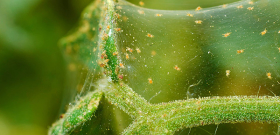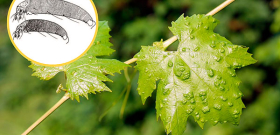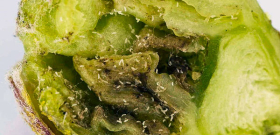
The strawberry mite is a dangerous quarantine pest of strawberries both in the open field and on industrial plantations and in home greenhouses and greenhouses. At the same time, it is most often necessary to fight it in greenhouses of any size, since it is here that optimal conditions for the pest are maintained, it multiplies rapidly and greatly harms the bushes.
With the mass reproduction of the tick, the bushes affected by it stop growing, young bushes become dwarfed, lose their leaves. Due to all these factors, most bushes either do not bear fruit at all, or give a much smaller yield than could be obtained from them, but healthy ones. Due to the insufficient development of the leaves, the bush leaves for the winter weakened and, in the event of a harsh winter, may die.
For example, the photo below shows strawberry bushes with clear signs of strawberry mite damage:
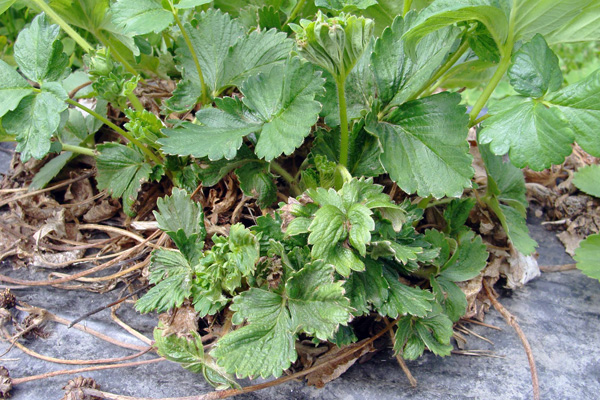
And here is a close-up of the tick itself:
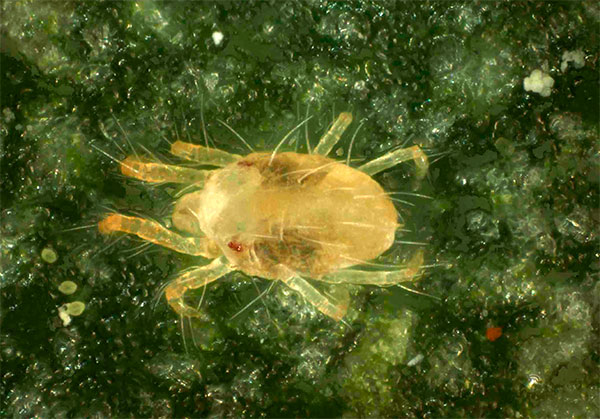
It is noticeable that the integument of the body of the pest is translucent - for this it is also called a transparent tick.
At the same time, the strawberry mite is a rather gentle and sensitive creature to environmental conditions. With a certain combination of temperature and humidity, it either develops very slowly or dies out altogether. Due to this, in fact, strawberry plantations in the southernmost regions of its cultivation suffer little from it - here the pest just does not withstand climatic conditions.
But even where the strawberry mite feels good, it is relatively easy to destroy it and prevent a serious damage to the plantation by it. Moreover, effective means for its extermination are quite accessible and inexpensive. Let's figure out how and with what it needs to be destroyed, and how not to confuse it with more dangerous pests.
What is this pest?
The strawberry mite is a member of the family of tarzonem mites, or tarzonemid (they are also called multi-claw mites), its Latin name is Tarsonemus fragariae. It is very small - so much so that it is almost impossible to see it with the naked eye, and from cultivated plants it settles only on strawberries.
The body length of adult female strawberry mites is 0.23 mm, males - 0.15 mm, that is, even the largest individuals of this species barely reach a quarter of a millimeter in length. Given that a significant number of them keep on the underside of the leaves, where they are well protected from sunlight, wind and raindrops, it is not surprising that it is almost impossible to find them on the bushes.
But in the photo under a microscope, strawberry mites look about the same as, for example, the well-known tetranychid spider mites:

But there are also differences (if you do not take into account the difference in size - tetranychids are 2-3 times larger).
Thus, most of the individuals in the population of strawberry mites have white covers. Eggs, due to this white color and regular rounded shape, are completely similar to pearls. Only a part of the females become darker towards the middle of autumn, acquire a yellowish-brown color - it is they who will leave for wintering in order to give rise to a new generation of pests in the spring.
The same spider mites that also often infect strawberries are usually yellowish-green, and in late summer and early autumn a large number of red individuals appear in the population. Moreover, all of them are much more noticeable due to their larger sizes.
Another difference of the strawberry mite is a fairly noticeable division of the body into the anterior part - the propodosoma, and the posterior part - the hysterosome. On both parts of his body there are several pairs of noticeable hairs, but most of them are located on the hysterosome. Spider mites do not have such a division - this is the specificity of tarzonema mites.
The picture below clearly shows the constriction, which divides the body of the pest into two noticeable parts:
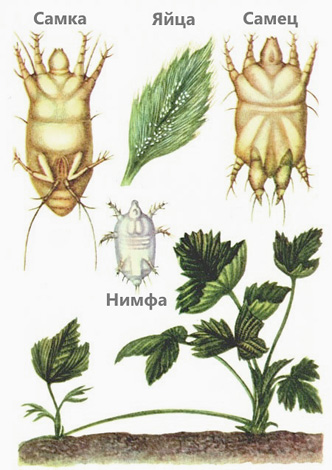
And, finally, the strawberry mite does not form a web and does not entangle the leaves of the bushes with it. Actually, this is the problem of its identification: it does not always occur to a person examining the bushes that the damage to the plant is caused by the tick. The leaves are affected in much the same way as in some diseases, the mites themselves are not visible to the naked eye, and the lesion itself can be mistaken for a viral disease.
On a note
Despite the obvious differences in size, shape and body color, many gardeners often refer to any mites found on strawberries, whether they are strawberry or spider mites, as "strawberry mites". Moreover, it is necessary to deal with both those and others with approximately the same means and methods. But they should be distinguished, if only because the identification of a spider mite requires subsequent protection of the entire site (spider mites are omnivorous and can move from strawberries to any other plant), and strawberries live only on strawberries and strawberries on the site.
In general, the strawberry mite is a species of the tarzonemid mite family, while the spider mite is a member of the tetranych mite family. It is the belonging of the strawberry mite to the tarzonemid family that explains some of the properties of its biology that are not characteristic of other phytophagous mites that are harmful in the garden or vegetable garden.
Lifestyle, nutrition and reproduction of the strawberry mite
Like many other phytophagous mites, the strawberry mite feeds on the contents of leaf cells near strawberry bushes. Individuals at all stages of their development pierce the leaf shell with cell walls and suck out the contents of the cells themselves, in place of which transparent dots remain. These points are not visible at first, but they begin to catch the eye when they accumulate in large quantities and when viewing a leaf in the sun.
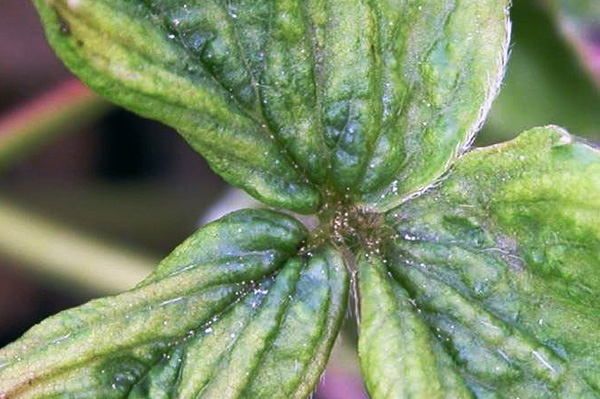
With severe damage to the strawberry leaf, clusters of mites look like grains of salt or sand.
Interestingly, the tick prefers to feed on bushes with very juicy leaves and sweet fruits - here it settles more often and multiplies in large numbers than on bushes with small leaves. The same spider mites are unpretentious and damage all strawberry bushes in approximately the same way, regardless of the structure of the leaves. And despite the fact that the strawberry mite does not affect the fruits, probably on the bushes that give the sweetest berries, the leaves also contain an increased amount of sugars in the cells and stimulate the accelerated reproduction of the pest.
In one spring-summer season, the strawberry mite develops in 4-5 generations. Females that have overwintered in a rosette at the base of leaf petioles, in April-May, when the air temperature rises to 13 ° C, rise to the leaves in order to feed and lay eggs.
On a note
The overwintered female can lay the first eggs only 2-3 days after the start of feeding.
In spring, at a temperature of about 13°C, eggs develop for 10 days. As the temperature rises, the rate of their development also increases in summer, at 25-30 °, the larvae hatch from them after 3.5-4 days.
Each female lives about 20-23 days as an adult and lays 12-15 eggs during this time.

Strawberry mites and their eggs at high (x40) magnification.
Larvae develop depending on air temperature from 4 to 8 days. Of this period, approximately 70% of the time they feed, the rest of the time they molt.
In autumn, when the air temperature drops below 20°C, dark yellow females appear after molts, which do not feed and do not lay eggs, but only mate with males. When the temperature drops to 12°C, these females go to the base of the leaf petioles for wintering, and the males die. In the spring, the cycle repeats again.
The number of strawberry mites on a bush reaches its summer peak in the first half of August, when flower buds form on the bushes. In the future, due to a gradual decrease in temperature, the rate of development of larvae and eggs decreases, and due to the death of the peak number of ticks from the July generation, mortality exceeds the birth rate, and the number of pests, although not significantly, decreases.
How a pest damages strawberries and what consequences can a plantation become infected with?
The main and only harm that the tick causes to strawberry bushes is damage to the leaves. In the spring, when there are still a few pests, these damages are insignificant, imperceptible and have almost no effect on the development of the bush. But in the summer, when there are a lot of ticks, they can literally kill whole leaves.It happens like this:
- A large number of empty shells from sucked out cells appear on the leaf, in places of accumulation they merge into large dry spots. A dry yellow area appears on the sheet in this place, easily torn off by fingers;
- Dry areas merge with each other, the edges of the sheet begin to curl into a tube;
- When more than half of the leaf surface dries out, it dies and falls off the bush.
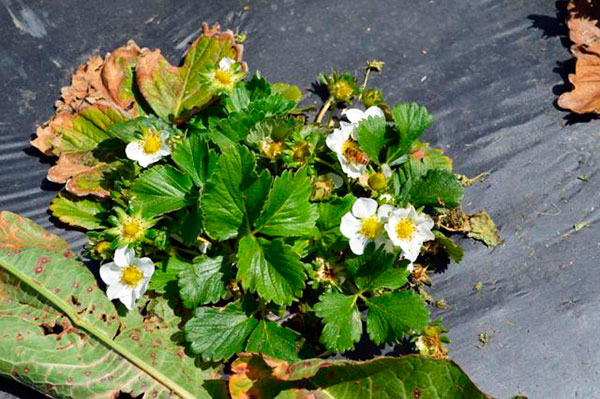
This is what a bush affected by a strawberry mite looks like.
Such damage to young leaves that appear after May fruiting is very dangerous. With a large number of mites, these leaves simply do not grow and remain underdeveloped. And since some of the old leaves die due to natural causes, and another part die from the nutrition of the same ticks, the next year the bush has only dwarf underdeveloped leaves. Normally, such a plant will not be able to bloom and bear fruit.
But even when fruiting on heavily damaged bushes, unsweetened fruits develop due to the fact that enough sugars do not have time to develop in leaves with a dry border. As a result, the commercial qualities of berries are reduced, which leads to a decrease in the profitability of the entire farm.
If mites get on the mustache that is being released, part of the mustache dies off without having time to take root. This reduces the rate of strawberry reproduction and slows down plantation renewal.
On the scale of a whole strawberry farm, all these damages lead to a decrease in yield, although a complete cessation of fruiting is almost never observed: if some of the bushes do not produce a crop, then at least some part continues to bear fruit, albeit in smaller quantities.Here, on the plantation, planting material degenerates and large quantities of purchased seedlings have to be used to renew the bushes.
Conditions optimal for the development of the pest
The strawberry mite has a remarkable feature of biology - it is very moisture-loving. This, in fact, is characteristic of all multi-claw mites. The most suitable air humidity for its development and reproduction is 90-95%. At 80%, he begins to show concern, many individuals migrate from the leaves to the base of the bush, closer to the ground, the rate of egg laying in females decreases, and molting is delayed in larvae. Already at 60% humidity, individuals at all stages of development begin to die.
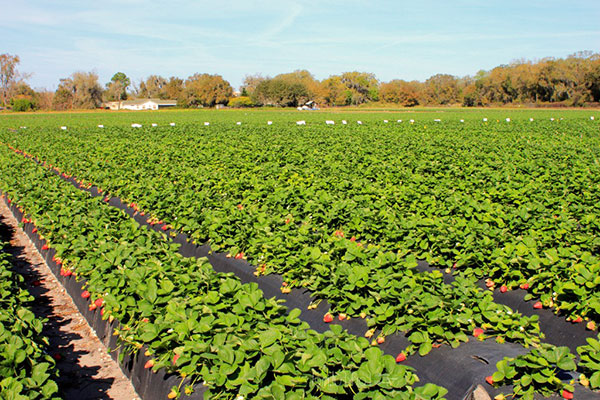
In dry sunny weather, strawberry mites begin to die.
This, by the way, greatly distinguishes the strawberry mite from the spider mite. The latter normally tolerates even very low humidity and the rate of its reproduction does not decrease even in very dry and hot weather. That is why it is more widely distributed and multiplies faster in the summer season.
In addition to love for high humidity, the strawberry mite is also quite thermophilic. The optimum temperature for its reproduction is 28-30°C, but not higher, since already at 33° a humidity of about 95% becomes fatal for its eggs.
The minimum temperature at which the population of tarzonemids continues to reproduce steadily is 9.5°C for no more than 4-5 days. Simply put, ticks tolerate random drops in air temperature to 10-11 ° C in summer, but if such temperatures are set for a week or more, the population dies out.
On a note
In acarology, specialists operate with such an indicator as the amount of biologically active heat.This is the sum of the average temperatures for all the days during which a particular biological event occurs. In particular, for the full development of one generation of the strawberry mite (oviposition, development of the embryo, hatching of the larva, its development and molting, transformation into adults, feeding and laying eggs of a new generation), 105 ° biological heat is required - 3.5 days at 30 ° C every day, or 10 days at 10-11°C daily.
Under natural conditions, such air parameters are maintained in the north of Ukraine, in the south of the European part of Russia and partly in central Russia, in Europe at the latitude of Germany, Switzerland, Holland, and northern France. It is here that the strawberry mite is most common in the wild and on garden strawberries in the open field. To the south - in the Caucasus, in the Crimea, in Bessarabia, in the Mediterranean - it also occurs, but is more rare and does not breed in significant quantities every year.
In greenhouses, the transparent mite harms throughout Europe, throughout Ukraine and the European part of Russia. It is in greenhouses that ideal conditions are maintained for it: high humidity, high temperature, stability of air parameters and high density of the strawberry bushes themselves. And it is here that it usually multiplies in huge quantities, causing significant harm and forcing special measures to combat it.

It is in greenhouse complexes that the most suitable microclimate exists for the reproduction of ticks, so strawberries grown in greenhouses are most susceptible to attack by parasites.
Signs of infestation of bushes with strawberry mites
The main first noticeable sign of damage to strawberries by a tick is the appearance of dry, curling edges on the edges of the leaves, with the general seeming well-being of the bush. Numerous full-fledged fruits can ripen on it, the petioles of the leaves will be quite strong, but the leaves give the impression of drying out. This is especially striking with constant normal soil moisture.
The photo below shows what a strawberry leaf affected by mites looks like:

It is useful to view such leaves from both sides with a magnifying glass or a field microscope. If mites are found on their surface, it is already necessary to start fighting them, since visible leaf damage occurs with a significant reproduction of the pest, which is dangerous for the bushes.
If the drying of the edges of the leaves was overlooked, or it was not given importance, the underdevelopment of young leaves will be the next to catch the eye. In produced petioles, they will still be full-fledged, but after opening they will not develop to their full size and remain small - half their normal size, or even less. Moreover, even with normal watering, they become faded, pale green, not like young leaves with a juicy color.
Around the same time, the mustache will die back or fail to take root. Bushes release them at the same time that they form new leaves, and therefore both of these signs appear at the same time.
If the fight against ticks is not carried out, then next year some of the bushes, and after 2-3 years, almost all plants will become dwarf and underdeveloped.
It is not worth counting on the fact that ticks themselves, or at least their clusters, will catch your eye when they multiply in especially large quantities.Due to their microscopically small size, it is practically impossible to see them, even looking closely at the sheet on purpose. Their presence on the bushes can only be judged by damage on the plants themselves.
Basic methods of struggle
It is necessary to fight the strawberry mite in all cases when its activity leads to visible damage to the leaves on strawberry bushes with the naked eye.
Normally, strawberry plantations always have either single individuals or small amounts of a transparent mite, which, however, under the pressure of natural predators and conditions, does not have time to multiply in such quantities during the season to seriously damage the bushes. Mass reproduction of the pest occurs when all predators on the bushes are destroyed by pesticides, and in suitable temperature conditions, in the absence of enemies, mites multiply rapidly. This is how pest outbreaks occur. In open ground on household plots, this does not happen every year and more often happens in seasons with rainy summers.
In addition, annual spikes in the number of strawberry mites can occur in industrial greenhouses, where high humidity and temperature are maintained throughout the warm season for the fruiting of remontant strawberries. Such conditions are ideal for the pest, and therefore it is here that you have to deal with it most often.
The basis for the destruction of mites on strawberries is the treatment of bushes with acaricides two or three times per season. The first time spraying is done in the spring, when new leaves grow, but before flowering. The second time is sprayed after harvest.The third time, processing is not always carried out, but only if the bushes are not mowed before wintering. It is believed that mowing and cleaning the affected bushes is more effective than the third treatment of the season (without mowing).

Strawberries from a tick are recommended to be processed 2-3 times per season.
It is impossible to process strawberries directly during flowering, as this may affect the quality of pollination of flowers. Moreover, you can not spray the bushes when the fruits appear.
Bushes are mowed in cases where, after fruiting, more than half of the bushes are affected by the pest. Mowing is carried out low to remove even the young affected leaves of this year. After mowing, they are removed from the plantation. Mowed leaves are desirable to burn.
Mowing is important to do before September, so that the females ready for wintering do not have time to go down to the base of the leaf petioles. If this is not allowed, almost all mites will be removed from the plantation with beveled leaves. A small number of individuals remaining on the plantation with competent prevention cannot lead to a mass outbreak of numbers next year.
In large farms, especially in which remontant strawberries are grown, bearing fruit until late autumn, it is advisable to apply biological control methods. Most often, predatory mites from the phytoseiidae family are used to destroy strawberry mites. After being released on strawberries, they begin to actively feed on a transparent tick, and they eat it at all stages of development: an adult individual eats up to 10-15 adult strawberry mites or 20-25 eggs per day.Due to such gluttony, the release of 1 predatory mite for each strawberry bush is enough to completely stop the development of the pest population.
The same predatory mites are even more effectively used for preventive purposes, releasing them to the plantation in the spring.
In any case, biological measures to combat strawberry mites are more preferable than the use of chemicals. Acariphagus mites are completely harmless to beneficial insects, people and domestic animals, and the refusal to process allows you to save a stable ecosystem in the garden, in which there are natural native enemies of pests.
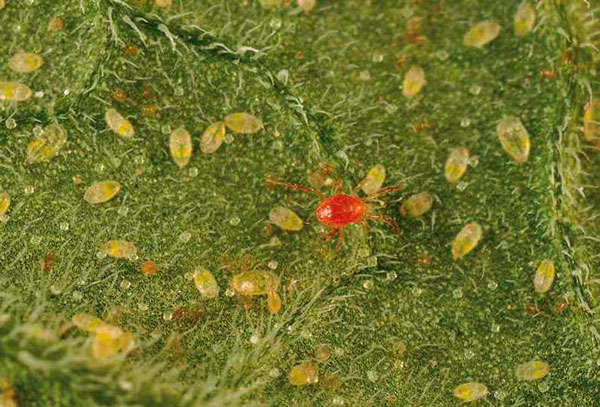
The predatory mite effectively helps to fight the strawberry mite.
The mechanical destruction of the strawberry mite is impossible, just as it cannot be scared away by any means - even the means that the pest is afraid of cannot force it to leave the leaves of the strawberry bush. The tick can either be destroyed or left on the bushes to thrive.
Chemical agents for the destruction of ticks
Highly specialized acaricides are considered the best chemical means for the destruction of strawberry mites, which allow the destruction of mites (not only strawberry mites, but also spider mites), but at the same time they are not dangerous for beneficial insects, primarily for bees.
These funds include:
- Envidor;
- Demitan;
- Orthus;
- Omite;
- Apollo;
- Nissoran.
At the same time, it is useful to carry out each subsequent treatment (including in the same year) with a different preparation, not the one with which the ticks were poisoned the previous time.
Only if it is impossible to buy specialized acaricides, insectoacaricides with a broader spectrum of action can be used:
- Preparations based on organophosphorus compounds (Metaphos, Karbofos or Fufanon-Nova, Phosfamide, Aktellik based on pirimiphos-methyl);
- Fitoverm;
- Acrofit;
- Tiodan;
- colloidal sulfur;
- Aktara and others.
They allow you to destroy not only ticks, but also many other pests, including aphids. But they also indiscriminately kill bees, predatory beetles (including ladybugs), and various pollinating insects. As well as narrowly targeted acaricides, they require the alternation of preparations in order to avoid the development of resistance in ticks to their active substances.
On a note
Bordeaux liquid against ticks is ineffective. This is a fungicide that, with abundant watering of the bushes, can kill some of the ticks, but you should not count on their complete destruction with this remedy.
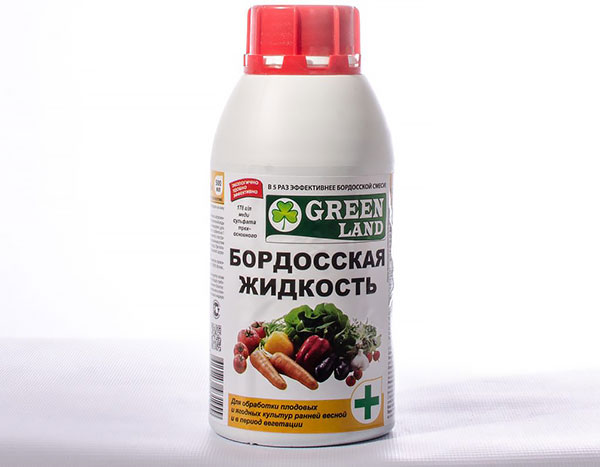
In protecting strawberries from strawberry mites, Bordeaux liquid does not give the expected result.
To some extent, folk remedies are effective against strawberry mites. For example, if you spray strawberry leaves with hydrogen peroxide, ammonia, or a strong decoction of onion peel, most of the mites on such treated leaves will die. However, practice shows that it is not possible to completely get rid of all mites on strawberries with the help of such means, and their preparation is much more troublesome and less reliable than buying a ready-made acaricidal preparation. Some of these folk remedies are very ineffective (for example, a soap solution or a soda solution), while others are very difficult to use (in particular, tar). Given that they are just as dangerous to insects and plants as chemicals, they do not have clear advantages over industrial acaricides and insecticides.
Review
We have such a region that the strawberry mite terrorizes in a year, and the cobweb breeds annually. Probably, we have already tried all the means that are on the market, we have experience, but we have not yet succeeded in completely defeating the tick. Specifically, funds. Actellik is effective, there is no strawberry mite until the end of the year, but it is very toxic to bees. That is, they either spray in the very early spring, or not spray at all. This, by the way, is written in the instructions for use, and many reviews confirm it. The cobweb has resistance to it. Both ticks are resistant to Marshal - they poisoned aphids, the aphids died out, the ticks remained. Intavir and Aktara are effective, together with ticks they remove the weevil, but poison the bees. So, in terms of strength of action, Fitoverm was the most powerful, in one year it was possible to literally save the plantation - all the bushes were affected, they had to be treated in July, after fruiting, the next year there were no ticks or symptoms. But now the tick, apparently getting used to it, is no longer so effective. This year Omite saved us, next year we will probably work with him.
Konstantin, Kostroma
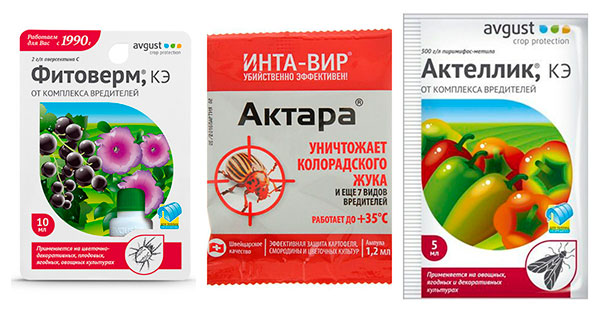
Preparations that destroy the strawberry mite, but require constant alternation.
Biological methods of destruction
The most effective biological product against all phytophagous mites on strawberries is the Amblyseius californicus mite. In size, it is somewhat larger than a transparent mite and comparable to a spider mite; its main food is precisely spider and strawberry mites. These predators are sold in batches of 10,000 pieces in a 1 liter container, they are released on strawberries at the rate of 1 mite per 1 bush in spring for prevention and in summer, when the first few lesions on the leaves are found on the bushes.Usually this is quite enough to save the plantation - in a few days the released amblyseius will destroy the bulk of the pests, and then completely clean the plants within 2-3 weeks. Until the end of the year, while the hot weather continues, predators will be on the bushes, feeding on other small pests, and will not allow the strawberry mite to multiply in large numbers.
Just like amblyseius, phytoseiulus mites are effective, but they are more difficult to buy: in Russia and Ukraine they are not grown, but mainly ampliseius are imported. At the same time, phytoseiulus have close requirements for humidity to those of tarzonemids: they multiply rapidly at high humidity, but die when it drops below 60%.
To some extent, the biological protection of strawberries is provided by Orius bugs. They can also be ordered from special nurseries, but they are considered more effective in combating whiteflies and aphids - their bugs are eaten first, and they switch to ticks when there is not enough main food for them.
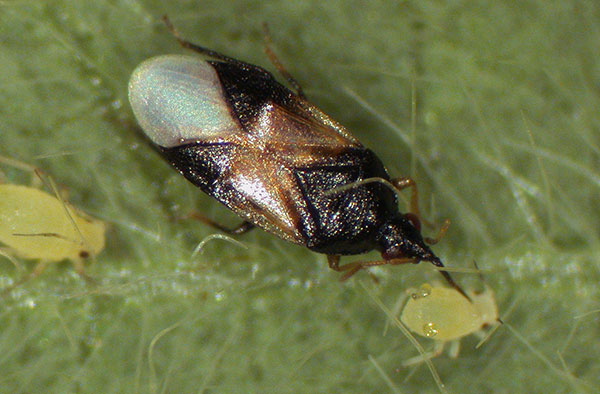
Orius bugs can partially help in the fight against strawberry mites.
In any case, biological protection against strawberry mites is practically incompatible with acaricide treatment. If, after the release of predators, the plants are treated with chemicals, all predators will die, and mites (possibly spider mites) accidentally introduced here will then multiply at an accelerated pace. Sometimes you can first treat strawberries with chemistry, and then, after 2-3 weeks, release predators on them. However, after a person manages to cure a strawberry from a tick, he relaxes and believes that this attack does not threaten him anymore.And the next time he notices pests, he no longer has time to order a biological product and poisons the garden again with the same (or even the same) chemical agent.
Prevention of infection of strawberries with strawberry mites
To protect strawberries from strawberry mite infestation, it is necessary first of all to subject all seedlings introduced to the farm to strict inspection and quarantine. It is on it that the pest most often enters the greenhouse or garden. Seedling bushes for this need to be checked with a microscope or a powerful magnifying glass.
If mites are found on the seedlings, then all the bushes purchased in the batch should be sprayed with any acaricide or insectoacaricide, and then kept away from the plantation for a week. It is also believed that disinfection of seedlings by the thermal method is effective - using a hair dryer set to a temperature of about 50-55 ° C, or water with a temperature of 55-60 ° C.
It is advisable to place the plants in such a quarantine in a room with dry air (they can be left in the room, since at home the air humidity is usually critically low for tarzonemids - about 50-60%).
On a note
Many varieties of strawberries are less affected by strawberry mites, but most of them have not very sweet berries. These are Vityaz, Torpedo, Dawn, Omskaya Early - they are not so much stable as they are simply not suitable for pest nutrition.
In summer and autumn, unambiguously affected leaves should be removed from the plantation, and after mowing strawberries, in general, all mowed green parts of the bushes. Mowed areas need to be loosened, fertilized, and fed, with a lack of precipitation - watered. All this creates conditions for the rapid restoration of the bushes.
Ideally, every spring, when the air temperature is set at 15-16°C, predatory mites should be released onto the plantation in prophylactic quantities - 1 tick per 2-3 bushes. In the presence or appearance of a strawberry mite or tetranychids, predators will feed on them and multiply at the same rate. As a result, they will not allow harmful mites to increase in number so much that they are dangerous to plants.
Video information about the strawberry mite: preventive and protective measures

